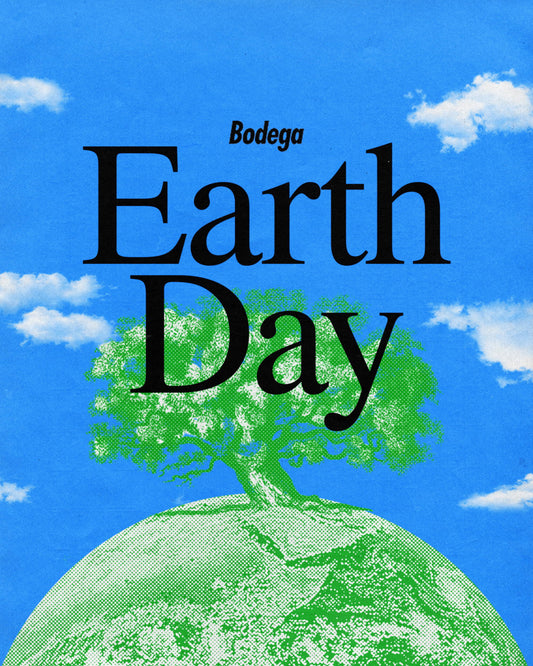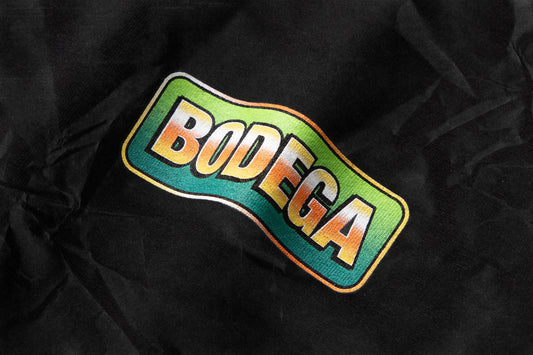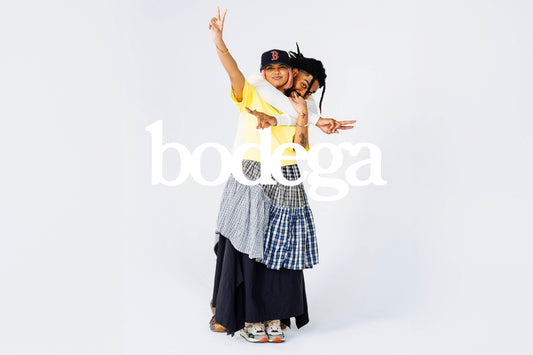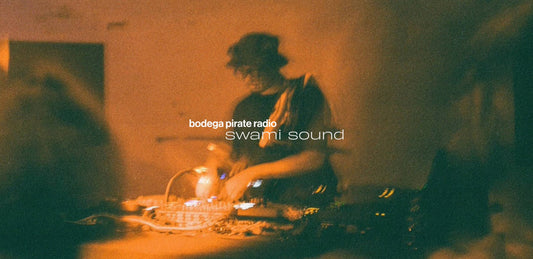This past month Salehe Bembury stopped by Bodega LA to talk shop, share his design philosophy, speak about the ever-changing state of streetwear, and of course, give us a little sneak peek into his upcoming collaboration with New Balance.
At just 34 years old, Bembury’s stacked resume is as diverse as they come, with experience ranging from bargain brands to the most elite and iconic Italian fashion houses. Combining his degree in industrial design with his lifelong love of sneakers, Bembury continues to cite growing up in NYC in the heyday of sneaker culture for his endless source of inspiration. Getting his start at Payless, he moved on to Cole Haan, did some time at Jon Buscemi’s GREATS and spent a couple of years heading up the Kanye West’s Yeezy footwear department. Today Bembury finds himself as Head Designer of Sneakers for Versace. But in addition to helping the famous luxury brand find a footing in the ever evolving world of upscale streetwear, Bembury also has the ability to step out on his own and lend his design ideas to other brands. Later this month, Bembury will release his own take on the New Balance 2002. Once known as the brand’s pinnacle running silhouette, the style has remained dormant for quite some time. Dubbing his iteration “Peace Be the Journey,” the bright, bold colorway and hairy suede composition are inspired by Bembury’s passion for the outdoors and are symbolic of the physical and metaphorical journey each of us find ourselves on.
"Connecting with nature and the outdoors is central to Salehe Bembury’s identity," notes Kevin Trotman, Product Manager of New Balance Collaborations. "We wanted his 2002 to be an authentic reflection of this aspect of his daily life. Details such as open hold mesh and different textures, together with the Antelope Canyon inspired graphic on the packaging, give a tactical feel to the product and serve as a bridge to achieving that aesthetic. ‘Peace Be The Journey’ can be interpreted in a multitude of ways, and we wanted this product to be worn, expressed and conceptualized in a way where each consumer’s styling and usage of the product is unique."
“We spent two straight days at Boston HQ, carving out the design for the shoe," Trotman continues. "Sitting alongside Salehe and witnessing his creative direction firsthand was an unforgettable experience. Salehe has broken into a space where he has influence on kids who are aspiring to become designers/marketers for global brands. He has taken the definition of what a designer is, and has flipped it into creating his personal brand and creative influence. As a Black man, it’s been amazing to see someone who looks like me, achieve what Salehe has achieved. While the fashion industry has long marketed to black consumers, representation in roles shaping the space has been light. Working with Salehe is important not only because of the talent and creative vision he brings to the project, but also because he is opening eyes of many kids that look like us and are realizing what was once a dream is now a reality."
Ladies and gentlemen, wIthout further ado... Salehe Bembury.
So, How did this New Balance thing come about? You display a certain level of versatility with your current projects. How do you manage to live within the different worlds you find yourself in.
This collaboration was born from a few inspiring conversations with Joe Grondin of New Balance. We initially met in a hotel room in Paris to discuss potential opportunities. Given the New Balance heritage I was familiar with, I expected color iterations of 990's, 574's etc. However what he pulled out of his bag was extremely unexpected. What was revealed were knit uppers with proprietary cushioning technology, innovative upper executions like the recently released Snow Peak sneaker, and new silhouettes like the Jaden Vision Racer. My interest peaked and the rest is history.
As for versatility, I believe that comes from the decade I have spent in the footwear industry. I have had the pleasure of working for virtually every facet of the business (Mass market, High Fashion...Yeezy). This diversity in professional experience has equipped me to sufficiently handle the majority of footwear tasks thrown my way.
I was looking at reviews and reactions from the public about some of your output and I saw one of your shoes described as “unrealistically amazing.” That’s an astounding description. How do you do it? haha.
I am humbled by that description. My creativity is largely inspired by a life-long love of footwear. I am on a journey to recapture the nostalgia that so strongly engaged me as a child. In childhood we had significantly less rules, so I try to adapt that mentality within my design. By dissolving the rules we can create more freely, and from that, a potentially "unrealistic" product can come to fruition.
How do you approach your overall designs? What are the priorities?
Every design problem requires a different solution. In some cases it is simply aesthetic, or the problem can live within function. With that said, there is no true priority beyond creating product that will sell. The most difficult task is maintaining a healthy balance between creativity and business. An old Design Director told me, once you successfully achieve this harmony, you can add a little something for yourself. In the case of the Chain Reaction...
it was the braille.
You have said that growing up in NYC is what created that passion for streetwear and the attitude that went along with it. Are you in LA now? Does that change the way you find inspiration? Has the change in scenery affected your output at all?
I moved to LA 5 years ago to design for Kanye. I spent my time at Yeezy so submerged in the work that I barely noticed I was in LA. However when that position ended, it was almost as if I looked up and noticed my surroundings. I started hiking everyday, camping often, and made nature a consistent part of my life.The drastic change in environment has affected my design work consciously and subconsciously in a very positive way. I would argue that nature and more specifically National Parks of the Southwest is the foundation of my New Balance collaboration.
Tell us about this New Balance. Why did you choose the 2002? What is the significance of the colorway? What accents can you note that you’re especially proud of?
First and foremost I knew that I needed to work on a classic New Balance silhouette. The initial reason I chose the 2002 is because of its visible technology. The early 2000's was a special period across brands of "Vis-Tec" design. Everybody was making sneakers that looked like they had alien parts. It was a very emotional way to design. Additionally, I was shown New Balance's collaboration offering for the year. I saw that there were a handful of 992's. Despite the 992 being a fan favorite, I wanted to stand a part from the pack.
Tell us about the name,"Peace be the Journey." Was the quote pulled from Cool Runnings and given more meaning in modern times?
It has a few meanings. The great equalizer is time. We all are on the same journey. I believe the destination of that journey is "peace". That "peace" can represent different things to different people. It could be money, love, or experience. We start our lives in the womb in the most peaceful state. We are ultimately on a journey to get back to that peace.
Speaking of journeys, we’ve heard you go on a lot of mountain walks. Does this physical journey bring you a sense of peace?
The 2nd meaning was discovered on my hikes. I have been hiking since moving to LA. However my 6-day a week, 2-hour, 4000-feet elevation hikes began in March when the hell we find ourselves in first began. While earth was infected with disease, hate, and pain, I'd start my mornings with a hike. After a 2 hour ascent, I would find myself 4000 feet above it all... in a place where there was no Covid, No Racism...No one at all. A place that was often above the clouds and completely silent. This was my peace. "Peace be the Journey".
What factors do you weigh when designing? What makes a great design and has that changed for you over time?
I recently watched an episode of "Abstract" about Paula Scher. She says that "You have to be in a state of play to design". I personally believe that in order for this to occur one needs to be very curious. The result of being curious within your profession, increases your versatility, your ability to speak another jargon, or most importantly to be able to approach a design problem from different angles. The consumer decides "what makes a great design". If the designer is able to fill the primary buckets of design execution, then that conversation will be short.
You’ve said that a good design inspires both positive and negative emotions. Explain what that means to you.
Think back to when you were a kid and you laced up the first pair of sneakers you really wanted. It's "that" feeling. It's the notion that through design lines, color palette, and storytelling, one can feel superhuman. Furthermore, in the case of some athletes, we would witness their super human power while they wore the same sneakers. After watching Superman you would make a cape out of a bed sheet and think you could fly. A good sneaker design is one that transcends function and taps into emotion.
Back when streetwear first came to be, no one would have ever assumed that high fashion would be jockeying to make a move to streetwear, or that streetwear would grow to such lengths. How do you make sense of that looking back?
Anything that is cool on a niche level eventually makes it way to the masses. The same could be said for the sneaker phenomenon. Fashion's shift came from the consumer valuing function more. From hard bottoms to sneakers, or pleated pants to tailored sweats. In many cases it is the demand of the masses that determine what is produced. However with over saturation, also comes imposters or an inability to properly speak the language. It's refreshing when the Kims, or Virgils of the world keep the translation authentic. Streetwear is a very particular jargon that many new-comers feel can be communicated with graffiti, hip-hop, or brown people. I believe that a vintage tee and New Balance is equally as streetwear as a mink coat and stilettos. Its authenticity comes from how it is communicated, worn, and most importantly owned.
From Payless to Versace, you could say you’ve developed some of the least expensive and most expensive sneakers out there. Are there things that remain the same through it all? I mean say what you will about Payless, you must have learned a lot there. Was there anything particularly proud of?
All design problems require an insight led solution. The value of the product doesn't change the approach.
Where do you derive inspiration? I assume old shoes can only get you so far, and instead it other non-shoe related ideas. What is the weirdest object of inspiration that has made it to a shoe.
The majority of my inspiration comes from my childhood. Growing up in downtown NYC served as inspiration for ten lifetimes. I'm often asked how I both know so many people, and how the relationships are so diverse and the answer is simply...New York. While I've moved on, that place is a beautiful juxtaposition of driven, colorful, horrible, beautiful, dangerous, ugly, amazing, blessed people that could inspire you to do anything. Those learnings and experiences are a strong driving force in what inspires my work.
What do you hope people might take away during these turbulent times?
To value time, health, and family. Also realize that you are surrounded by many dark energy individuals and to protect your neck at every turn. Word to Wu-Tang.
How have you dealt with creativity during these times? Has it been difficult or have you been able to turn the weirdness into inspiration?
The #1 complaint by all creatives is having a lack of time. The #1 thing that all creatives received during this period is..."time". If you are a creative and haven't used the last 6 months to plot, organize, and execute...it was time wasted.
Lately it just seems like so much is wrong in the industry. Would you agree? What signs of progress do you see when it seems like all the focus is on what’s wrong?
My observation has been that many corporations feel the need to make "change". Some of the acts are genuine, some are from social / corporate pressure, and the others are the "sheep". Despite the motivation, if the act is in the name of progress, I see no fault. This is the first time that there seems to be a mass movement for permanent progress and change. There is now what seems to be a shift towards accountability, and empathy. The fight is not over, nor is the finish line close. The route has been established and the majority of the industry seems like they're ready for the journey.
Do you feel like you have a mission or need to change the industry?
Inclusion, opportunity, and resources for people that look like me.






